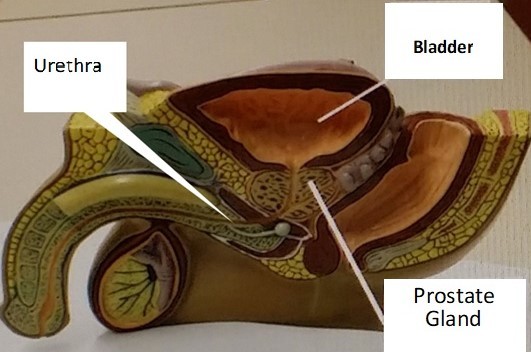【Major Points】
- The prostate gland part of male reproductive system and benign prostatic hyperplasia (BPH) is a common disease relating to aging.
- Common symptoms of BPH include having difficulty starting to urinate, frequent urination, urinating more often at night, dribbling, and acute urinary retention.
- Common treatments of BPH include medicines, surgery and laser treatment.
- Daily life care instructions include avoiding holding urination, drinking alcohol, and taking medication without prescription, decreasing fluid intake after dinner, keeping personal hygiene, and moderating exercise. Seek medical attention if your bladder feels full but you cannot urinate or blood in your urine.
What is Benign Prostatic Hyperplasia (BPH)?
The prostate gland is a gland that is part of the male reproductive system. It lies at the outlet of the urinary bladder where it surrounds the urethra ( as below figure). The main function of the prostate is to produce part of the semen and help sperm get into the urethra. Benign Prostatic Hyperplasia (BPH) is a common disease that relates to aging, and occurs among most male while age over fifty. The symptoms of BPH and quality of life can both be improved after appropriate treatment.
The prostate gland is a gland that is part of the male reproductive system. It lies at the outlet of the urinary bladder where it surrounds the urethra ( as below figure). The main function of the prostate is to produce part of the semen and help sperm get into the urethra. Benign Prostatic Hyperplasia (BPH) is a common disease that relates to aging, and occurs among most male while age over fifty. The symptoms of BPH and quality of life can both be improved after appropriate treatment.

Figure. Prostate Gland Location
What are the symptoms of BPH?
- Having difficulty starting to urinate: decreased strength of the urine stream or unable to urinate right away.
- Frequent urination: need to urinate frequently. Nocturia: often need to get up at night to urinate.
- Dribbling: dribbling at the end of urination.
- Acute urinary retention: sudden onset of inability to urinate despite urinary bladder distension.
- Blood in urine.
Those who have the above symptoms are not necessarily the benign prostatic hyperplasia, please go to the urology outpatient department for consultation.
How is BPH treated?
- Medications: prescription is according to the size of the prostate and the severity of symptoms.
- TransUrethral Resection of the Prostate (TURP)
- Laser therapy.
Cautions for daily life:
- Avoid holding urine. Try to limit fluid intake after dinner in order to avoid frequent urination during night time.
- Avoid alcohol and medications with anti-histamine (anti-allergy).
- Personal hygiene: regular showers and keep your perineum area clean.
- Keep a healthy mind and body. Regular exercise according to your physical ability.
- Regular follow-up in the outpatient clinics and taking medications as prescribed. Please seek for medical attention immediately, if symptoms such as sudden onset of inability to urinate, acute urinary retention, urinary bladder distension, or hematuria, persist.
Reference
- Foster, H. E., Dahm, P., Kohler, T. S., Lerner, L. B., Parsons, J. K., Wilt, T. J., & McVary, K. T. (2019). Surgical management of lower urinary tractsymptoms attributed to benign prostatic hyperplasia: AUA Guideline Amendment 2019. The Journal of urology, 202(3), 592-598. https://doi.org/10.1097/JU.0000000000000319
- Rastrelli, G., Vignozzi, L., Corona, G., & Maggi, M. (2019). Testosterone and benign prostatic hyperplasia. Sexual medicine reviews, 7(2), 259-271. https://doi.org/10.1016/j.sxmr.2018.10.006
- Vickman, R. E., Franco, O. E., Moline, D. C., Vander Griend, D. J., Thumbikat, P., & Hayward, S. W. (2019). The role of the androgen receptor in prostate development and benign prostatic hyperplasia: A review. Asian Journal of Urology, 7(3),191-202. https://doi.org/10.1016/j.ajur.2019.10.003
Quiz
Please answer the following questions:
Nursing Instruction Satisfaction
Please log in to rate
- Location
-
- Category
- Disease

